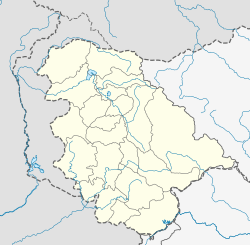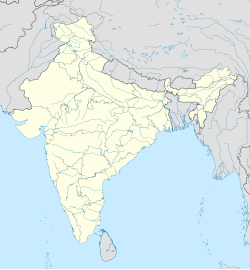Keran is a tehsil in Kupwara district, Jammu and Kashmir, India.[3] It is on the bank of the Kishanganga River. The village lies on the Line of Control. The Keran block includes four panchayats: Keran, Mandian, Mandian-A and Kundian Pathroo.[4]
Keran | |
|---|---|
Village | |
 Keran in Jammu and Kashmir, as seen from the opposite side of the LOC | |
| Coordinates: 34°39′02″N 73°57′03″E / 34.6505°N 73.9507°E | |
| Country | |
| Union Territory | |
| District | Kupwara |
| Block | Keran |
| Demonym(s) | Kerani, Keranwala, Keraniya |
| Languages | |
| • Official | Kashmiri, Hindi, Urdu, Dogri, English[1][2] |
| Time zone | UTC+5:30 (IST) |
| PIN | 193224 |
| Website | kupwara |
The adjacent habitation on the Pakistani side across the boundary is also called Keran. The Kishanganga river (known by the name Neelum on the other side), flowing through the village, acts as the natural border between the two habitations. While both sides have the same predominant religion, social and cultural practices differ greatly. The people are not allowed by Indian and Pakistani officials to intermingle. Keran village is surrounded by dense forests. Shalabhatu, a village in the Keran sector, is divided between Indian-administered Jammu and Kashmir and Pakistan-administered Kashmir.[5] It was among the foremost infiltration routes used in the early 1990s by militants. The village has three border posts: Khokhri, Kulari and Mangerta.
After the reiteration of the ceasefire agreement between India and Pakistan in 2021, the village attracted tourists for the first time, offering a unique view of Pakistan-administered Kashmir. Before this, only the military and locals had access to the village.[6]
History
editThe village is said to have been established by Raja Karan in the 11th century.[7] In 1990, the Indian Army relocated the villagers due to frequent firing and shelling by the Pakistan Army. In 1992, a flood swept over the cultivated land. With the fresh cease-fire accords between the governments of both countries, the valley has witnessed peace across the border. With the opening of border tourism in 2012, Keran has become one of the favourite offbeat locations for tourists. The year 2023 has seen the highest footfall of tourists proceeding through Keran Valley.[8] One of the reasons for this is the introduction of e-permissions for non-resident tourists.[9]
See also
editReferences
edit- ^ "The Jammu and Kashmir Official Languages Act, 2020" (PDF). The Gazette of India. 27 September 2020. Retrieved 27 September 2020.
- ^ "Parliament passes JK Official Languages Bill, 2020". Rising Kashmir. 23 September 2020. Archived from the original on 24 September 2020. Retrieved 30 May 2021.
- ^ "Tehsils | District Kupwara, Government of Jammu & Kashmir | India". Retrieved 3 February 2024.
- ^ "Panchayat in District KUPWARA". Department of Rural Development and Panchayat Raj, Govt. of J&K. Retrieved 3 February 2024.
- ^ "Army's claim over Keran operations under cloud". The Hindu. 20 October 2013. ISSN 0971-751X. Retrieved 3 February 2024.
- ^ Iqbal, Naveed (23 August 2023). "Bunkers give way to homestays in this remote J&K village". Indian Express. Keran. Archived from the original on 23 August 2023. Retrieved 23 August 2023.
- ^ "Villages of historical importance in Kupwara district". Archived from the original on 30 May 2013. Retrieved 8 October 2013.
- ^ Geelani, Syed Rizwan (19 January 2024). "Tourist footfall in Kupwara skyrockets to 3 lakh in 2023". Greater Kashmir. Retrieved 3 February 2024.
- ^ "Border Tourism: Kupwara Admin Starts E-permission for Tourists". Kashmir Observer. 13 June 2022. Retrieved 3 February 2024.

